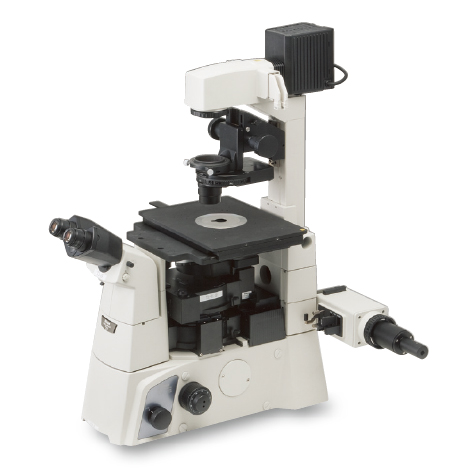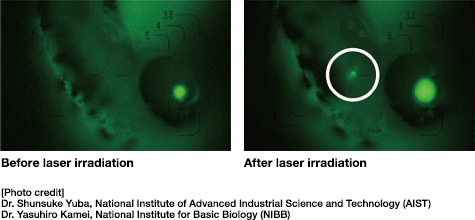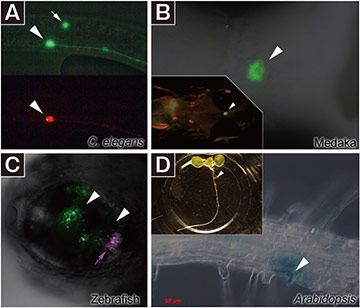- HOME >
- Application System >
- Bio-photonics >
- Laser Optical tweezers - Mini type
A system to trigger expression of desired genes under biological microscope.
Localized heating feature with 1480nm near infrared laser
Simultaneous application of laser irradiation and fluorescent observation is possible
Add-on type system for existing upright/inverted fluorescence microscopes (Adaptive models: Olympus BX Series, IX Series Nikon Ti, TE2000)

Result of Gene Expression Check Test

Infrared Laser-Evoked Gene Operator (IR-LEGO) is developed as the world’s first technology by consolidated research team led by Dr. Shunsuke Yuba at National Institute of Advanced Industrial Science and Technology (AIST). This is a technique to induce specified genes that are under the control of a heat shock promoter at defined time, by heating single cells that consist of genetically-modified organisms, with an infrared laser. IR-LEGO could be adopted to all the genetically-modified experimental organisms that the heat shock promoters function and the internal focus of infrared laser are available. Because of its high efficiency and reproducibility, and less detrimental effect from laser, IR-LEGO is a new and prospective tool for future gene function analysis.
| Part Number | JP Yen | Equipment Configuration | Add to Cart |
| IR-LEGO-490 | 4,400,000 | 490mW, CW laser/Electric focus | |
| IR-LEGO-490/P | 5,100,000 | 490mW, CW and pulsed laser/Electric focus | |
| IR-LEGO-200 | 3,700,000 | 200mW, CW laser/Electric focus | |
| IR-LEGO-200/P | 4,400,000 | 200mW, CW and pulsed laser/Electric focus |
| Part Number | JP Yen | Equipment Configuration | Add to Cart |
| IR-LEGO-490/mini | 2,800,000 | 490mW, CW laser | |
| IR-LEGO-490/mini/E | 3,100,000 | 490mW, CW laser/Electric focus | |
| IR-LEGO-490/P/mini | 3,500,000 | 490mW, CW and pulsed laser | |
| IR-LEGO-490/P/mini/E | 3,800,000 | 490mW, CW and pulsed laser/Electric focus | |
| IR-LEGO-200/mini | 2,100,000 | 200mW, CW laser | |
| IR-LEGO-200/mini/E | 2,400,000 | 200mW, CW laser/Electric focus | |
| IR-LEGO-200/P/mini | 2,800,000 | 200mW, CW and pulsed laser | |
| IR-LEGO-200/P/mini/E | 3,100,000 | 200mW, CW and pulsed laser/Electric focus | |
| LMS-AD-NI-BP | 50,000 | Adapter for Nikon microscopes (compatible with Ti and TE2000) |
|
| LMS-AD-OL-BP | 50,000 | Adapter for Olympus microscopes (compatible with IX73 and IX83) |
*1 Specify the manufacturer and model of your microscope.
*2 Some models of microscopes are not compatible.
Contact our International Sales Division for more information.
*3 Carrying-in and adjustment fees for system setup are required separately.
*4 The electric focus models are equipped with a function to correct the laser focal position based on
chromatic aberration of each objective lens (preset system).
Utilizing a strain (cell) that carries a heat shock promoter driven transgene, an infrared (IR) laser is irradiated at parts indicated by white arrowhead marks.

The red flourescence by RFP is obtained on a neuron and neuraxon that irradiated by a laser (white arrowhead).
[Photo credit] Dr. Motoshi Suzuki & Dr. Shin Takagi, Nagoya University
[Photo credit]
Dr. Tomonori Deguchi,
National Institute of Advanced Industrial Science and Technology (AIST)
Dr. Yasuhiro Kamei,
National Institute for Basic Biology (NIBB)
Kaede is partially photoconverted after its expression (purple arrow).
[Photo credit] Dr. Mariko Itoh & Dr. Kohei Hatta, University of Hyogo
[Photo credit] Dr. Hiroko Urawa & Dr. Kiyotaka Okada,National Institute for Basic Biology (NIBB)

